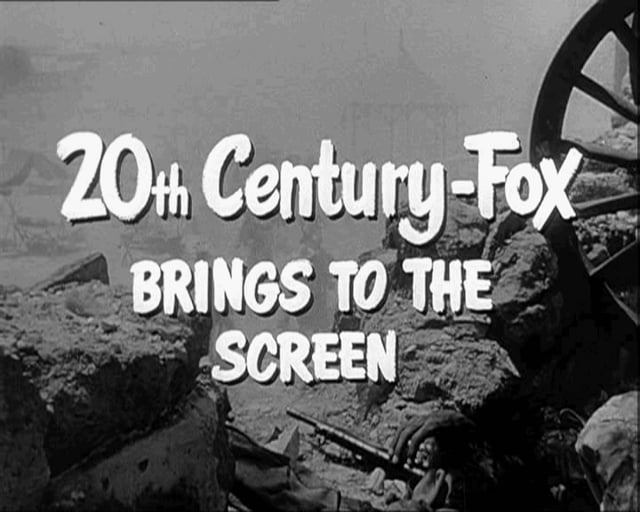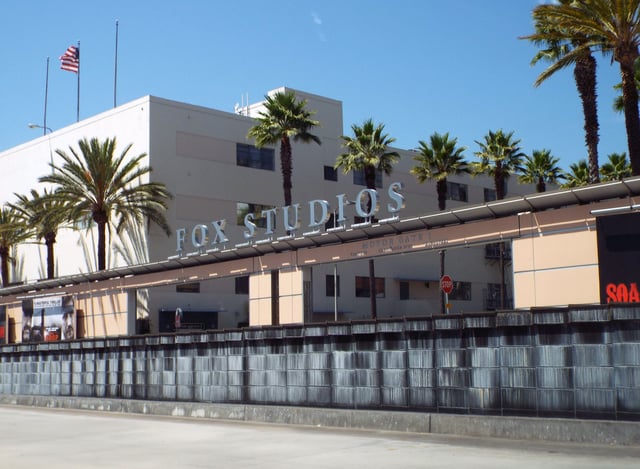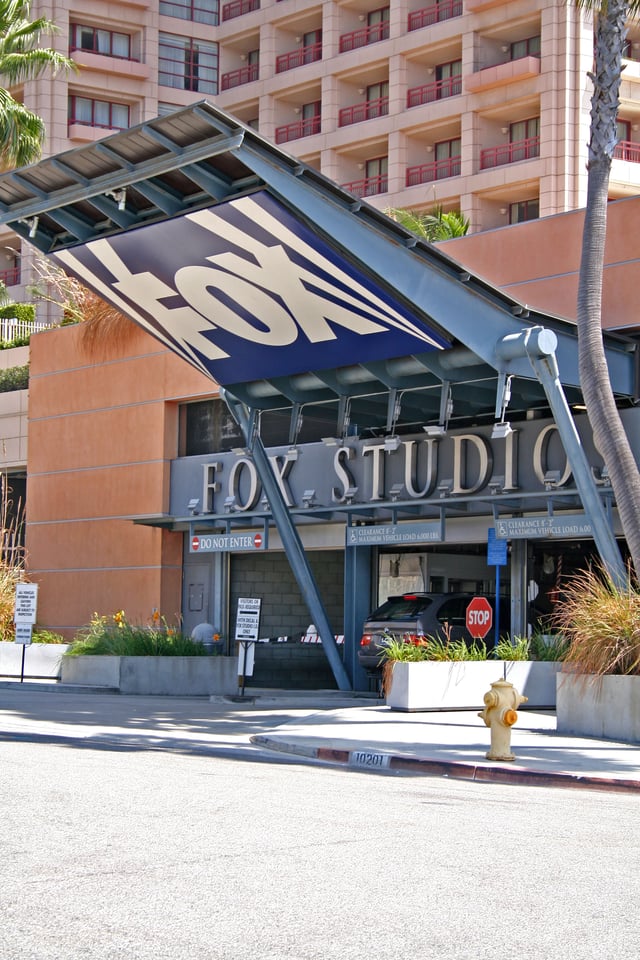20th Century Fox

20th Century Fox

| Subsidiary | |
| Industry | Film |
| Predecessor | |
| Founded | May 31, 1935 |
| Founders | |
| Headquarters | Fox Studio Lot Building 88, 10201 WestPico Boulevard,, |
| Worldwide | |
| Emma Watts(vice chair, president) | |
| Products | Motion pictures,television films |
| 2,300 (2018) | |
| Parent | The Walt Disney Studios |
| Divisions | |
| Subsidiaries | |
| Website | |
| Footnotes / references[1][2][3][4] | |
Twentieth Century Fox Film Corporation (colloquial: Twentieth Century Fox, 20th Century Fox, 20th, Fox) is an American film studio that is a subsidiary of The Walt Disney Studios, a division of The Walt Disney Company.[5] The studio is located on the Fox Lot in the Century City area of Los Angeles.[6]
For over 83 years, it was one of the "Big Six" major American film studios; formed from the merger of the Fox Film Corporation and Twentieth Century Pictures in 1935. In 1985, the studio was acquired by News Corporation, which was succeeded by 21st Century Fox in 2013 following the spin-off of its publishing assets. In 2019, Disney acquired 20th Century Fox through its merger with 21st Century Fox.[7]
| Subsidiary | |
| Industry | Film |
| Predecessor | |
| Founded | May 31, 1935 |
| Founders | |
| Headquarters | Fox Studio Lot Building 88, 10201 WestPico Boulevard,, |
| Worldwide | |
| Emma Watts(vice chair, president) | |
| Products | Motion pictures,television films |
| 2,300 (2018) | |
| Parent | The Walt Disney Studios |
| Divisions | |
| Subsidiaries | |
| Website | |
| Footnotes / references[1][2][3][4] | |
History
Founding

Carmen Miranda in The Gang's All Here. In 1946, she was the highest-paid actress in the United States.[8]

Alice Faye, Don Ameche, and Carmen Miranda in That Night in Rio

From the 1952 film Viva Zapata!

The entrance to 20th Century Fox's studio lot.
Twentieth Century Pictures' Joseph Schenck and Darryl F. Zanuck left United Artists over a stock dispute, and began merger talks with the management of financially struggling Fox Film, under President Sidney Kent.[9][10] Spyros Skouras, then manager of the Fox West Coast Theaters, helped make it happen (and later became president of the new company).[9] The company had been struggling since founder William Fox lost control of the company in 1930.[11]
The company established a special training school.
Lynn Bari, Patricia Farr and Anne Nagel were among 14 young women "launched on the trail of film stardom" on August 6, 1935, when they each received a six-month contract with 20th Century Fox after spending 18 months in the school. The contracts included a studio option for renewal for as long as seven years.[13]
For many years, 20th Century Fox claimed to have been founded in 1915, the year Fox Film was founded.
For instance, it marked 1945 as its 30th anniversary.
However, in recent years it has claimed the 1935 merger as its founding, even though most film historians agree it was founded in 1915.[14]
The company's films retained the 20th Century Pictures searchlight logo on their opening credits as well as its opening fanfare, but with the name changed to 20th Century-Fox.
After the merger was completed, Zanuck signed young actors to help carry 20th Century-Fox: Tyrone Power, Linda Darnell, Carmen Miranda, Don Ameche, Henry Fonda, Gene Tierney, Sonja Henie, and Betty Grable. Fox also hired Alice Faye and Shirley Temple, who appeared in several major films for the studio in the 1930s.[15][16] Higher attendance during World War II helped Fox overtake RKO and Metro-Goldwyn-Mayer to become the third most profitable film studio. In 1941, Zanuck was commissioned as a lieutenant colonel in the U.S. Signal Corps and assigned to supervise production of U.S. Army training films. His partner, William Goetz, filled in at Fox.[17]
In 1942, Spyros Skouras succeeded Kent as president of the studio.[18] During the next few years, with pictures like The Razor's Edge, Wilson, Gentleman's Agreement, The Snake Pit, Boomerang, and Pinky, Zanuck established a reputation for provocative, adult films. Fox also specialized in adaptations of best-selling books such as Ben Ames Williams' Leave Her to Heaven (1945), starring Gene Tierney, which was the highest-grossing Fox film of the 1940s. Fox also produced film versions of Broadway musicals, including the Rodgers and Hammerstein films, beginning with the musical version of State Fair
After the war, and with the advent of television, audiences slowly drifted away.
20th Century-Fox held on to its theaters until a court-mandated "divorce"; they were spun off as Fox National Theaters in 1953.[19] That year, with attendance at half the 1946 level, 20th Century-Fox gambled on an unproven gimmick.
Noting that the two film sensations of 1952 had been Cinerama, which required three projectors to fill a giant curved screen, and "Natural Vision" 3D, which got its effects of depth by requiring the use of polarized glasses, Fox mortgaged its studio to buy rights to a French anamorphic projection system which gave a slight illusion of depth without glasses. President Spyros Skouras struck a deal with the inventor Henri Chrétien, leaving the other film studios empty-handed, and in 1953 introduced CinemaScope in the studio's groundbreaking feature film The Robe.[20]
Zanuck announced in February 1953 that henceforth all Fox pictures would be made in CinemaScope.[21] To convince theater owners to install this new process, Fox agreed to help pay conversion costs (about $25,000 per screen); and to ensure enough product, Fox gave access to CinemaScope to any rival studio choosing to use it.
Seeing the box-office for the first two CinemaScope features, The Robe and How to Marry a Millionaire (also 1953), Warner Bros., MGM, Universal Pictures (then known as Universal-International), Columbia Pictures and Disney quickly adopted the process. In 1956 Fox engaged Robert Lippert to establish a subsidiary company, Regal Pictures, later Associated Producers Incorporated to film B pictures in CinemaScope (but "branded" RegalScope). Fox produced new musicals using the CinemaScope process including Carousel and The King and I
Production and financial problems
Zanuck's successor, producer Buddy Adler, died a year later.[24] President Spyros Skouras brought in a series of production executives, but none had Zanuck's success. By the early 1960s, Fox was in trouble. A new version of Cleopatra had begun in 1959 with Joan Collins in the lead.[25] As a publicity gimmick, producer Walter Wanger offered $1 million to Elizabeth Taylor if she would star;[25] she accepted and costs for Cleopatra began to escalate. Richard Burton's on-set romance with Taylor was surrounding the media. However, Skouras' selfish preferences and inexperienced micromanagement on the film's production did nothing to speed up production on Cleopatra.
Meanwhile, another remake — of the 1940 Cary Grant hit My Favorite Wife — was rushed into production in an attempt to turn over a quick profit to help keep Fox afloat. The romantic comedy entitled Something's Got to Give paired Marilyn Monroe, Fox's most bankable star of the 1950s, with Dean Martin and director George Cukor. The troubled Monroe caused delays on a daily basis, and it quickly descended into a costly debacle. As Cleopatra's budget passed $10 million, eventually costing around $40 million, Fox sold its back lot (now the site of Century City) to Alcoa in 1961 to raise cash. After several weeks of script rewrites on the Monroe picture and very little progress, mostly due to director George Cukor's filming methods, in addition to Monroe's chronic sinusitis, Monroe was fired from Something's Got to Give [25] and two months later she was found dead. According to Fox files she was rehired within weeks for a two-picture deal totaling $1 million, $500,000 to finish Something's Got to Give (plus a bonus at completion), and another $500,000 for What a Way to Go. Elizabeth Taylor's disruptive reign on the Cleopatra set continued unchallenged from 1960 into 1962, though three Fox executives went to Rome in June 1962 to fire her. They learned that director Joseph L. Mankiewicz had filmed out of sequence and had only done interiors, so Fox was then forced to allow Taylor several more weeks of filming. In the meantime during that summer of 1962 Fox released nearly all of its contract stars, including Jayne Mansfield.[26][27]
With few pictures on the schedule, Skouras wanted to rush Zanuck's big-budget war epic The Longest Day (1962),[25] a highly accurate account of the Allied invasion of Normandy on June 6, 1944, with a huge international cast, into release as another source of quick cash. This offended Zanuck, still Fox's largest shareholder, for whom The Longest Day was a labor of love that he had dearly wanted to produce for many years. After it became clear that Something's Got to Give would not be able to progress without Monroe in the lead (Martin had refused to work with anyone else), Skouras finally decided that re-signing her was unavoidable. But days before filming was due to resume, she was found dead at her Los Angeles home and the picture resumed filming as Move Over, Darling, with Doris Day and James Garner in the leads. Released in 1963, the film was a hit.[28] The unfinished scenes from Something's Got to Give were shelved for nearly 40 years. Rather than being rushed into release as if it were a B-picture, The Longest Day was lovingly and carefully produced under Zanuck's supervision. It was finally released at a length of three hours, and was well received.
At the next board meeting, Zanuck spoke for eight hours, convincing directors that Skouras was mismanaging the company and that he was the only possible successor.
Zanuck was installed as chairman, and then named his son Richard Zanuck as president.[29] This new management group seized Cleopatra and rushed it to completion, shut down the studio, laid off the entire staff to save money, axed the long-running Movietone Newsreel, and made a series of cheap, popular pictures that restored Fox as a major studio. The saving grace for the studio's fortunes came from the tremendous success of The Sound of Music (1965),[30] an expensive and handsomely produced film adaptation of the highly acclaimed Rodgers and Hammerstein Broadway musical, which became a significant success at the box office and won five Academy Awards, including Best Director (Robert Wise) and Best Picture of the Year.
Fox also had two big science-fiction hits in the 1960s: Fantastic Voyage (1966), and the original Planet of the Apes (1968), starring Charlton Heston, Kim Hunter, and Roddy McDowall. Fantastic Voyage was the last film made in CinemaScope, which was ultimately replaced by Panavision lenses.
Zanuck stayed on as chairman until 1971, but there were several expensive flops in his last years, resulting in Fox posting losses from 1969 to 1971.
Following his removal, and after an uncertain period, new management brought Fox back to health.
Under president Gordon T. Stulberg and production head Alan Ladd, Jr., Fox films connected with modern audiences. Stulberg used the profits to acquire resort properties, soft-drink bottlers, Australian theaters and other properties in an attempt to diversify enough to offset the boom-or-bust cycle of picture-making.
Foreshadowing a pattern of film production still yet to come, in late 1973 20th Century Fox joined forces with Warner Bros.
to co-produce The Towering Inferno (1974),[31] an all-star action blockbuster from producer Irwin Allen. Both studios found themselves owning the rights to books about burning skyscrapers. Allen insisted on a meeting with the heads of both studios, and announced that as Fox was already in the lead with their property it would be career suicide to have competing movies. Thus the first joint-venture studio deal was struck. In hindsight, while it may be commonplace now, back in the 1970s, it was a risky, but revolutionary, idea that paid off handsomely at both domestic and international box offices around the world.
In 1977 Fox's success reached new heights and produced the most profitable film made up to that time, Star Wars. Substantial financial gains were realized as a result of the film's unprecedented success: from a low of $6 in June 1976, stock prices more than quadrupled to almost $27 after Star Wars' release; 1976 revenues of $195 million rose to $301 million in 1977.[32]
Marvin Davis and Rupert Murdoch

Fox Plaza, Century City headquarters completed in 1987.

The Fox Broadcasting Company's Los Angeles studios in 2005.
With financial stability came new owners, when Fox was sold for more than $700 million in 1981 to investors Marc Rich and Marvin Davis. Fox's assets included Pebble Beach Golf Links, the Aspen Skiing Company and a Century City property upon which Davis built and twice sold Fox Plaza.
By 1984 Rich had become a fugitive from justice, having fled to Switzerland after being charged by U.S. federal prosecutors with tax evasion, racketeering and illegal trading with Iran during the Iran hostage crisis. Rich's assets were frozen by U.S. authorities.[33] In 1984 Marvin Davis bought out Marc Rich's 50% interest in 20th Century Fox Film Corporation for an undisclosed amount,[33] reported to be $116 million.[34] Davis sold this interest to Rupert Murdoch for $250 million in March 1985. Davis later backed out of a deal with Murdoch to purchase John Kluge's Metromedia television stations.[34] Murdoch went ahead alone and bought the stations, and later bought out Davis' remaining stake in Fox for $325 million.[34]
To gain FCC approval of Fox's purchase of Metromedia's television holdings, once the stations of the long-dissolved DuMont network, Murdoch had to become a U.S. citizen. He did so in 1985, and in 1986 the new Fox Broadcasting Company took to the air. Over the next 20-odd years the network and owned-stations group expanded to become extremely profitable for News Corp.
The company formed its Fox Family Films division in 1994 to boost production at the studio and would handled animation films. In February 1998, following the success of Anastasia, Fox Family Films changed its name to Fox Animation Studios and drop its live action production which would be picked up by other production units.[35]
Since January 2000 this company has been the international distributor for MGM/UA releases. In the 1980s Fox — through a joint venture with CBS called CBS/Fox Video — had distributed certain UA films on video; thus UA has come full circle by switching to Fox for video distribution. Fox also makes money distributing films for small independent film companies.
In late 2006, Fox Atomic was started up[36] under Fox Searchlight head Peter Rice and COO John Hegeman[37] as a sibling production division under Fox Filmed Entertainment.[36] In early 2008, Atomic's marketing unit was transferred to Fox Searchlight and Fox, when Hegeman moved to New Regency Productions. Debbie Liebling became president. After two middling successes and falling short with other films, the unit was shut down in April 2009. The remaining films under Atomic in production and post-productions were transferred to Fox and Fox Spotlight with Liebling overseeing them.[37]
In 2008 Fox announced an Asian subsidiary, Fox STAR Studios, a joint venture with STAR TV, also owned by News Corporation. It was reported that Fox STAR would start by producing films for the Bollywood market, then expand to several Asian markets.[38] In 2008, 20th Century Fox started Fox International Productions.[39]
In August 2012, 20th Century Fox signed a five-year deal with DreamWorks Animation to distribute in domestic and international markets. However, the deal did not include the distribution rights for previously released films which DreamWorks Animation acquired from Paramount Pictures later in 2014.[40] Fox's deal with DreamWorks Animation ended on June 2, 2017 with Captain Underpants: The First Epic Movie, with Universal Pictures taking over the distribution deal with DreamWorks Animation due to NBCUniversal's acquisition of DreamWorks Animation on August 22, 2016, starting on February 22, 2019 with the release of How to Train Your Dragon: The Hidden World
In 2012 Rupert Murdoch announced that News Corp. would be split into two publishing and media-oriented companies: a new News Corporation, and 21st Century Fox, which operates the Fox Entertainment Group and 20th Century Fox. Murdoch considered the name of the new company a way to maintain the 20th Century Fox's heritage as the group advances into the future.[41][42]
In September 2017, Locksmith Animation formed a multi-year production deal with 20th Century Fox, who will distribute Locksmith's films, with Locksmith aiming to release a film every 12–18 months. The deal was to bolster Blue Sky's output and replace the loss of distributing DreamWorks Animation films.[45]
Technoprops, a VFX company that worked on Avatar and The Jungle Book, was purchased in April 2017 to operate as Fox VFX Lab.
Technoprops' founder Glenn Derry would continue to run the company as vice president of visual effect reporting to John Kilkenny, VFX president.[46]
On October 30, 2017, Vanessa Morrison was named president of a new created 20th Century Fox division, Fox Family, reporting to the Chairman & CEO and Vice Chairman of 20th Century Fox.
The family division would develop films that appeal to younger moviegoers and their parents both animated films and films with live action elements.
Also, the division would oversee the studio's family animated television business, which produce based holiday television specials on existing film properties, and oversee feature film adaptation of its TV shows.[47] To replace Morrision at Fox Animation, Andrea Miloro and Robert Baird were named co-presidents of 20th Century Fox Animation.[48]
20th Century Fox issued a default notice in regards to its licensing agreement for the under-construction 20th Century Fox World theme park in Malaysia by Genting Malaysia Bhd. In November 2018 Genting Malaysia filed suit in response and included soon to be parent The Walt Disney Company.[49]
Disney subsidiary
On December 14, 2017, The Walt Disney Company announced plans to purchase most of the 21st Century Fox assets, including 20th Century Fox.[50] After a Comcast bid, Disney counterbid.[51] On July 27, 2018, Disney and Fox shareholders approved the merger between the two companies.[7] Although the deal was completed on March 20, 2019,[53] 20th Century Fox will not relocate to the Walt Disney Studios in Burbank, but will instead continue to be headquartered on the Fox Studio Lot in Century City, which is currently leased to Disney by the Fox Corporation, 21st Century Fox's successor, for seven years.[6] Various units were moved out from under 20th Century Fox at acquisition and months after the merger plus there were several rounds of layoffs.
Television
20th Television is Fox's television syndication division. 20th Century Fox Television is the studio's television production division.
During the mid-1950s features were released to television in the hope that they would broaden sponsorship and help distribution of network programs.
Blocks of one-hour programming of feature films to national sponsors on 128 stations was organized by Twentieth Century Fox and National Telefilm Associates.
Twentieth Century Fox received 50 percent interest in NTA Film network after it sold its library to National Telefilm Associates.
This gave 90 minutes of cleared time a week and syndicated feature films to 110 non-interconnected stations for sale to national sponsors.[54]
Buyout of Four Star
Rupert Murdoch's 20th Century Fox bought out the remaining assets of Four Star Television from Ronald Perelman's Compact Video in 1996.[55] Most of Four Star Television's library of programs are controlled by 20th Century Fox Television today.[56][57][58] After Murdoch's numerous buyouts during the buyout era of the eighties, News Corporation had built up financial debts of $7 billion (much from Sky TV in the UK), despite the many assets that were held by NewsCorp.[59] The high levels of debt caused Murdoch to sell many of the American magazine interests he had acquired in the mid-1980s.
Music
Between 1933 and 1937, a custom record label called Fox Movietone was produced starting at F-100 and running through F-136. It featured songs from Fox movies, first using material recorded and issued on Victor's Bluebird label and halfway through switched to material recorded and issued on ARC's dime store labels (Melotone, Perfect, etc.). These scarce records were sold only at Fox Theaters.
Fox Music has been Fox's music arm since 2000. It encompasses music publishing and licensing businesses, dealing primarily with Fox Entertainment Group television and film soundtracks.
Prior to Fox Music, 20th Century Records was its music arm from 1958 to 1982.
Radio
The Twentieth Century Fox Presents radio series[60] were broadcast between 1936 and 1942. More often than not, the shows were a radio preview featuring a medley of the songs and soundtracks from the latest movie being released into the theaters, much like the modern day movie trailers we now see on TV, to encourage folks to head down to their nearest Picture House.
The radio shows featured the original stars, with the announcer narrating a lead up that encapsulated the performance.
Motion picture film processing
From its earliest ventures into movie production, Fox Film Corporation operated its own processing laboratories.
The original lab was located in Fort Lee, New Jersey along with the studios. A lab was included with the new studio built in Los Angeles in 1916.[61] Headed by Alan E. Freedman, the Fort Lee lab was moved into the new Fox Studios building in Manhattan in 1919.[62] In 1932, Freedman bought the labs from Fox for $2,000,000 to bolster what at that time was a failing Fox liquidity.[63][64] He renamed the operation "DeLuxe Laboratories" which much later became DeLuxe Entertainment Services Group. In the 1940s Freedman sold the labs back to what was then 20th Century Fox and remained as president into the 1960s. Under Freedman's leadership, DeLuxe added two more labs in Chicago and Toronto and processed film from studios other than Fox.
Divisions
Fox Atomic
Fox Atomic was a youth-focused film production company and division of Fox Filmed Entertainment that operated from 2006 to April 2009. Atomic was originally paired with Fox Spotlight Pictures under the same leadership.
In late 2006, Fox Atomic was started up[36] under Fox Searchlight head Peter Rice and COO John Hegeman[37] as a sibling production division under Fox Filmed Entertainment.[36] Debbie Liebling transferred to Fox Atomic in 2007 from Fox.[37] In January 2008, Atomic's marketing unit was transferred to Fox Searchlight and Fox,[65] when Hegeman moved to New Regency Productions. Debbie Liebling became president. After two middling successes and falling short with other films, the unit was shut down in April 2009. The remaining films under Atomic in production and post-productions were transferred to Fox and Fox Spotlight with Liebling overseeing them.[37]
- Films in production at shut down and transferred to other Fox units
I Love You, Beth Cooper (July 10, 2009)[65] Fox release, 1492 Pictures production company, directed by Chris Columbus and starring Hayden Panettiere[37]
Jennifer's Body (Sept. 18 2009)[65] Fox release, directed by Karyn Kusama and starring Megan Fox [37]
Post Grad through Fox Searchlight directed by Vicky Jenson and starring Alexis Bledel[37]
- Films in development at shut down[65]
28 Months Later a continuation of the zombie series
Accidentes
Fox Family
Fox Family is family-friendly production division of 20th Century Fox under president Vanessa Morrison.
Besides family-friendly theatrical films, the division oversees mixed media (live-action with animation), family animated holiday television specials based on film properties and film features based on TV shows.
On October 30, 2017, Morrison was transferred from her post as president of 20th Century Fox Animation, the prior Fox Family Films, to be president of a newly created 20th Century Fox division, Fox Family, which as a mandate similar to Fox Family Films. The division pick up supervision of a "Bob’s Burgers" film[47] and some existing deals with animation producers, including Tonko House.[66] With the sale of 21st Century Fox to Disney in March 2019, rights to The Dam Keeper feature animated film returned to Tonko House.[67] With the August 2019 20th Century Fox slate overhaul announcement, Fox properties such as Home Alone, Night at the Museum, and Diary of the Wimpy Kid have been assigned for Disney+ release and assigned to Fox Family.[68]
- Upcoming productions
an unnamed The Simpsons Movie
The Prom Goer’s Interstellar Excursion based film, produced with Chernin Entertainment[70]
Paper Lanterns live-action/animated family film written by Jonny Sun and produced with Chernin Entertainment[71]
The Garden live-action/ CGI musical film base on book of Genesis's the Garden of Eden with Franklin Entertainment[72]
Fox VFX Lab
Fox VFX Lab is visual effects company division of 20th Century Fox under president John Kilkenny that was acquired in 2017 known as Technoprops.
Besides their visual effects activities, the division oversees different parts of the world to apply for and work on projects that include films such as Avatar, The Jungle Book, Rogue One: A Star Wars Story, Teenage Mutant Ninja Turtles: Out of the Shadows, Doctor Strange, and Warcraft[73] and also video game properties like Need for Speed (2015), Battlefield 1, Rainbow Six Siege, Watch Dogs 2, Just Cause 3, Rise of the Tomb Raider, Assassin's Creed Syndicate, Mafia III, Halo 4, Mortal Kombat XI, Far Cry (Far Cry 5 and Primal), Call of Duty (Call of Duty: Advance Warfare and Black Ops III) and Sonic the Hedgehog (Sonic Forces and Team Sonic Racing).[74][75]
Fox International Productions
Fox International Productions was the division of 20th Century Fox in charge of local production in 12 territories in China, Europe, India and Latin America from 2008 to 2017.
In 2008, 20th Century Fox started Fox International Productions under president Sanford Panitch.
The company had $900 million in box-office receipts by the time Panitch left the company for Sony on June 2, 2015.[39] Co-president of worldwide theatrical marketing and distribution for 20th Century Fox Tomas Jegeus was named president of Fox International Productions effective September 1, 2015.[76] The company struck a development and production deal in November 2015 with Zhejiang Huace, a Chinese entertainment group.[77] In December 2017, 20th Century Fox film chairman-CEO Stacey Snider indicated that Fox International Productions would be dissolved in favor of each local and regional offices producing or acquiring projects.[78]
Logo and fanfare

2009 logo with the News Corporation byline.
20th Century Fox uses a well-known searchlight structure logo.
Its fanfare was originally composed in 1933 by Alfred Newman. It was re-recorded in 1935 when 20th Century-Fox was officially established.
The original layout of the logo was designed by special effects animator and matte painting artist Emil Kosa Jr.. The logo was originally created as a matte painting on several layers of glass and animated frame-by-frame.
In 1953, Rocky Longo, an artist at Pacific Title, was hired to recreate the original logo design for the new CinemaScope picture process. Alfred Newman also re-composed the logo's fanfare with an extension to be heard during the CinemaScope logo that would follow after the Fox logo for films made using the new lenses.
George Lucas insisted the CinemaScope version be used in Star Wars (1977). John Williams composed the film's opening theme in the same key as the fanfare (B♭ major), serving as an extension to it of sorts. In 1980, Williams conducted a new version of the extended fanfare for The Empire Strikes Back
On March 6, 1981, Longo repainted and updated the logo design.
The Fox fanfare was also re-orchestrated in 1981.
In 1994, after a few failed attempts, Fox in-house television producer Kevin Burns was hired to produce a new logo for the company, this time using the then-new process of computer-generated imagery (CGI) adding more detail and animation, with the longer 21-second Fox fanfare would be used as the underscore.
In 1997, Alfred's son David Newman recorded the new version of the fanfare to reopen the Newman Scoring Stage (originally known as Fox Scoring Stage).
In 2009, a newly updated CGI logo produced by Blue Sky Studios debuted. A "75th anniversary" version of the logo was introduced to coincide with 20th Century Fox's 75th anniversary the following year.[14]
The now-defunct 21st Century Fox, the corporate successor to the old News Corporation, used a logo incorporating a minimalist representation of the searchlights featured in the logo.[41]
Films
The Academy Film Archive houses the 20th Century Fox Features Collection which contains features, trailers, and production elements mostly from the Fox, Twentieth Century, and Twentieth Century-Fox studios, from the late 1920s–1950s.[79]
Highest-grossing films
I ‡—Includes theatrical reissue(s).